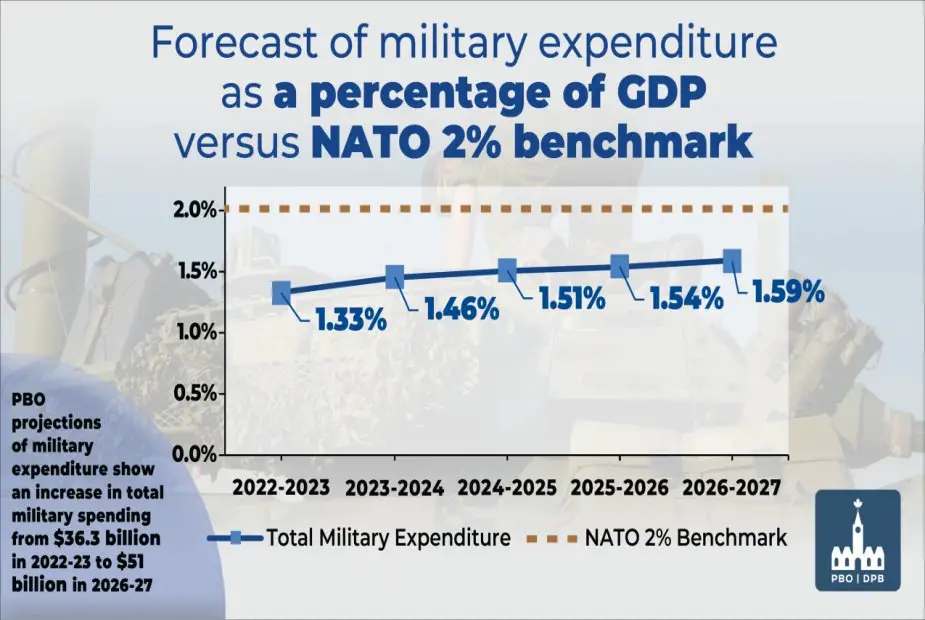Breaking news
Canada plans to meet 2% NATO defense spending pledge.
Canada finds itself at a critical juncture in terms of its commitment to defense spending. With geopolitical challenges on the rise and growing threats from various quarters, the country is facing mounting pressure to increase its military budget and meet the 2% pledge on defense spending, in line with NATO's expectations.
Follow Army Recognition on Google News at this link

Canada pledged to spend 2% of GDP on its military. (Picture source: Canada's Parliament)
Compared to its neighbor, the United States, the Canadian Armed Forces are significantly smaller in terms of personnel and defense budget. The United States has approximately 1.3 million active-duty military personnel, which is nearly 20 times more than Canada. Furthermore, the U.S. defense budget is around 778 billion U.S. dollars, which is over 34 times larger than Canada's defense budget in Canadian dollars.
Canada's military expenditure has shown a notable increase over the years, rising by approximately 40% in nominal terms from 2014 to 2021. Looking ahead, the projected military expenditure is expected to continue its upward trend, with estimates indicating a total spending increase from $36.3 billion in 2022-23 to $51.0 billion in 2026-27. Despite this growth, the percentage of military spending as a share of GDP is projected to rise only to 1.59% over the same period, up from the current 1.33%. To meet NATO's 2% of GDP benchmark, the Canadian government would need to allocate between $13 and $18 billion more per year over the next 5 years. This additional investment would be essential to achieve the targeted defense spending level recommended by NATO.
For decades, Canada has been known for its cautious approach to allocating significant resources to its defense budget. However, recent events have shifted public opinion, with a majority of Canadians now recognizing the necessity of bolstering national security through increased defense spending.
At the heart of the debate lies the pressing need for modernizing the Canadian Armed Forces and acquiring cutting-edge military equipment. A focal point of contention has been the decision surrounding the purchase of next-generation fighter jets. The choice of acquiring the F-35 fighter jet has been under scrutiny, with experts questioning the anticipated economic and industrial benefits. As the debate intensifies, it becomes evident that transparent and evidence-based evaluations are vital in determining the efficacy and appropriateness of defense procurement projects.
As Canada seeks to bolster its defense capabilities, strategic investments in cutting-edge military equipment and technology facilities will play a vital role in modernizing the Canadian Armed Forces. Advanced fighter jets, like the F-35 Lightning II, with its advanced stealth capabilities and sophisticated avionics, offer enhanced situational awareness and combat effectiveness. Additionally, the purchase of drones and unmanned aerial vehicles (UAVs) can significantly augment surveillance and reconnaissance capabilities.
Investing in modern maritime patrol aircraft, like the Boeing P-8 Poseidon, can strengthen Canada's ability to patrol its vast territorial waters and protect its maritime interests. These aircraft are equipped with advanced sensors and radar systems, enabling effective surveillance and anti-submarine warfare operations.
Upgrading the naval fleet with modern frigates and submarines is vital for securing Canada's maritime borders and supporting international peacekeeping efforts. Investing in advanced naval technology, such as stealth technology and integrated command systems, can enhance naval capabilities significantly.
In the face of escalating cyber threats, establishing a robust cybersecurity infrastructure is essential. Specialized cybersecurity centers equipped with advanced tools and skilled personnel can bolster Canada's ability to defend against cyberattacks on critical infrastructure and secure sensitive data.
Canada's expertise in space technology presents an opportunity to strengthen its defence capabilities. Investments in satellite technology, space surveillance, and satellite communication systems can enhance intelligence gathering and support military operations across the globe.
Furthermore, research and development centers focused on military technology can foster innovation and indigenous development of defence equipment. Collaborations with academic institutions and private sector organizations can further enhance Canada's military technological advancements.
By prioritizing these areas and making strategic investments, Canada can reinforce its defence capabilities, demonstrate its commitment to collective security, and play a more active role in international peacekeeping efforts, in alignment with NATO's expectations. Such initiatives will not only strengthen Canada's position in the global security landscape but also foster a more secure and resilient nation.
Canada stands at a crossroads in terms of national security and defence. The recent geopolitical developments have underscored the need for a more proactive approach to defence spending, in accordance with NATO's guidelines. By committing to meet the 2% pledge and taking strategic steps to acquire cutting-edge military equipment, Canada can demonstrate its resolve in safeguarding its interests and contributing effectively to global security efforts. The time has come for Canada to raise its defence spending game and reinforce its position as a respected member of the international community within the framework of NATO.


























